#King Akrisios
Text


The King of Manthos, the young Mijararos, had payed a friendly visit to King of Selinódasos, the wealthy King Akrísios, who was also married to Mijaros' aunt, Queen Laonome. This was a courtesy visit, but with an agenda. They had an important issue to discuss: To strengthen the ties between the two kingdoms through an agreement on marriage.

When seeing his potential wife, King Mijararos was quite startled.
- But she is still a child! I don't think this is a good idea.
- Well, you knew her age already, didn't you? She is almost ten winters.
- When grandmother said "marry your cousin" I didn't realize she meant Princess Nikh. I always assumed she meant Princess Euthalia. This is not what I had prepared for.

- Princess Euthalia is already spoken for. We have already made an agreement with the Kingdom of Koiláda Chalkoú.
- I don't mind cousin Mijarare, Nikh said, I know you will be a kind husband. And also grandma and uncle Heraklis will be there, so I'm not afraid.
- Thank you for that, Nikh my dear, but it's not that easy. There are expectations that you simply can't fill.
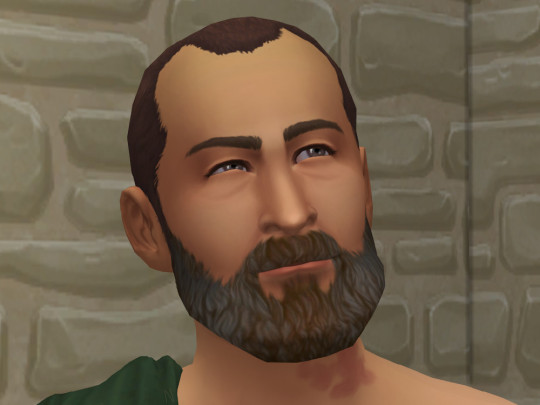
- There would be a long period of engagement of course, at least three winters. The important thing now is the agreement, not the fulfillment.
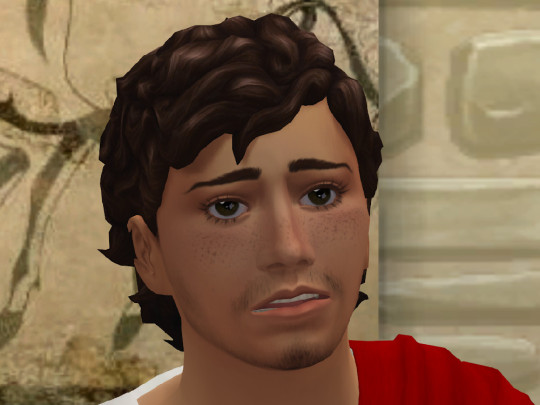
- I hear you uncle, and I respect that, but I ... I just can't. The age difference bothers me, and it will probably do so for many years. The gap is too large. I'm sorry, I will just have to decline.
- Mother will not be pleased, Laonome said. The whole family will be so disappointed.
- It can't be helped aunt Laonome, this is impossible. I will have to look for a wife elsewhere I'm afraid.
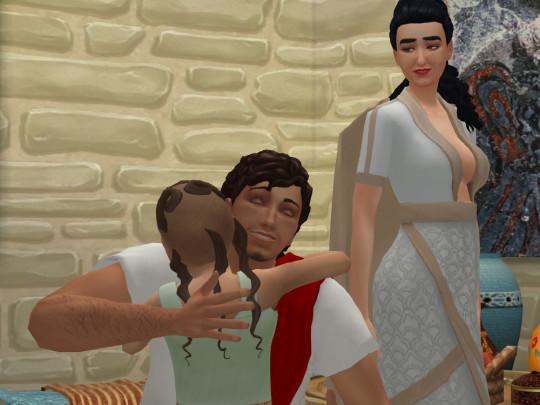
- Is it my fault cousin Mijarare? Am I too ugly? You don't love me?
- Of course I love you! Just not in a husband-and-wife-way, okay? Besides, you are the prettiest girl in the whole kingdom and any young man will be proud to marry you, as soon as you get a bit older.
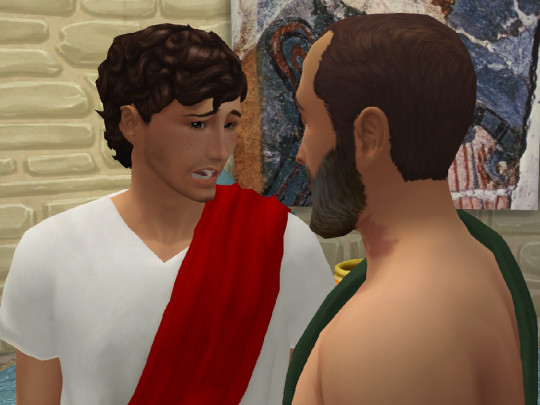
- I'm really sorry uncle. But might I suggest that you consider my brother Linos for Nikh? They are closer in age, and he is second to the throne.
- I was hoping for a more prestigious marriage, so I don't know. It's not what I had planned for my daughter. This is most unfortunate.
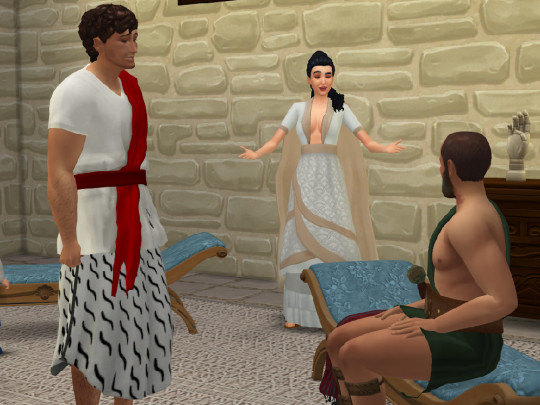
- My men! Laonome cut in. We must be able to solve this somehow.
- I don't see how, Mijararos answered.
- Not me neither, Akrisios agreed.
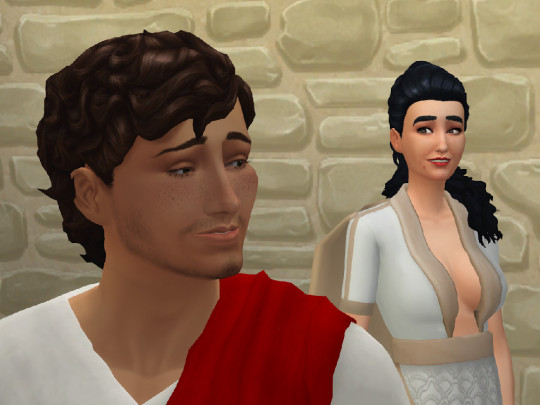
- Dear nephew, would you consider marrying Euthalia, if she wasn't spoken for?
- I would. We are about the same age at least.
- So if we can reach an agreement with the King of Koiláda Chalkoú to let her go, would we have an agreement? Even if the dowry would be lower?
- Why should it be lower?
- Because we would have to offer something to the King of Koiláda Chalkoú. As a compensation.

- Do you think he would be willing to discuss it?
- It's worth a try.
- And Euthalia, how would she feel about it, would she consider living at Manthos palace?
- Oh, absolutely. She wasn't very keen on going to Koiláda Chalkoú, that's for sure. She's been sulking for weeks now.
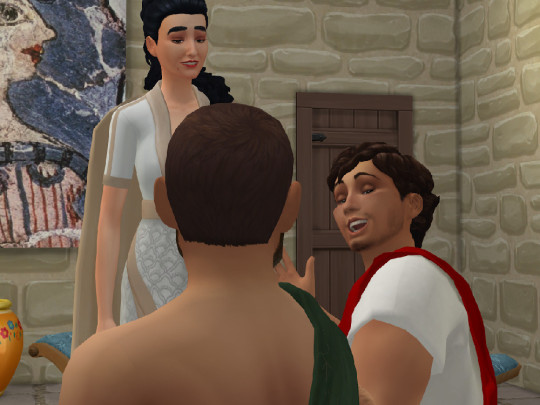
- Ironically, that sounds promising. So maybe we have an agreement then?
- Provided the King of Koiláda Chalkoú agrees; yes!
- When I come home, Mijararos added, I will suggest that the house of Manthos and grandmother assists with the compensation, just to make sure he will think it's worth it.

- You make it sound so easy, Laonome laughed.
- What?
- "I will suggest that grandmother assists". That woman is not known for accepting any suggestions easily. Unless it's in her interest.
- It's just a matter of making her realizing just that, it is in her interest. I know what I will have to do.
.
Previous (Chapter 10) | Index | Character overview | Next
#KyriaT#KyriaT-stories#Chapter Eleven#ts4 story#sims 4 story#history challenge#ts4 history challenge#Generation 2#Early civilization sims#Early civ sims#Once Upon A Time#The First Ones#King Mijararos#Queen Laonome#King Akrisios#Princess Nikh#simblr
19 notes
·
View notes
Text
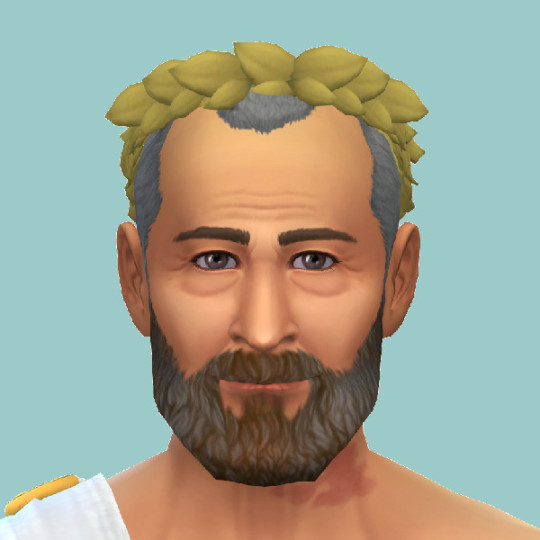
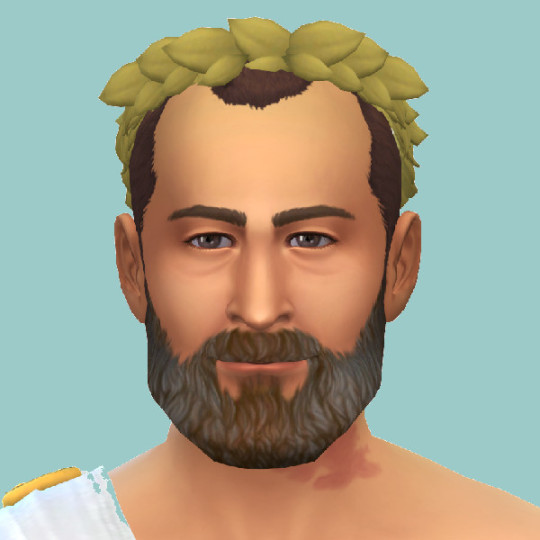
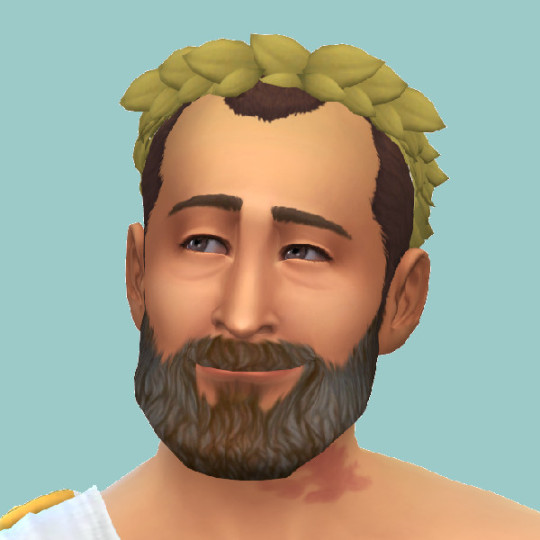
King Akrisios I
GENDER - Male
AGE - Elder
King of Selinódasos
ASPIRATION - Mansion Baron
TRAITS: Bookworm, Language Savant, Slob
SIGN: Leo
PARENTS - unknown
PARTNER - Laonome Amphytriona, Bisera Akrisiou,
CHILDREN - Euthalia, Nikh, Philokratis, Monachos
Download: Not available
Story: Once Upon A Time - The first ones
Family tree: The first ones
He is King in a very small kingdom, and he is a relaxed and intellectual monarch. He enjoys debating and small talk, something that absolutely is an advantage when you are royalty.
He is a practical man, and when his wife Laonome died it didn't take him long to find a new wife. For his children's sake, he claimed.
#Story character#King Akrisios#Generation 2#side character#Once Upon A Time#Akrisios Akrisios#Royal family of Selinódasos#King of Selinódasos#Early Civilization#KyriaT
0 notes
Text
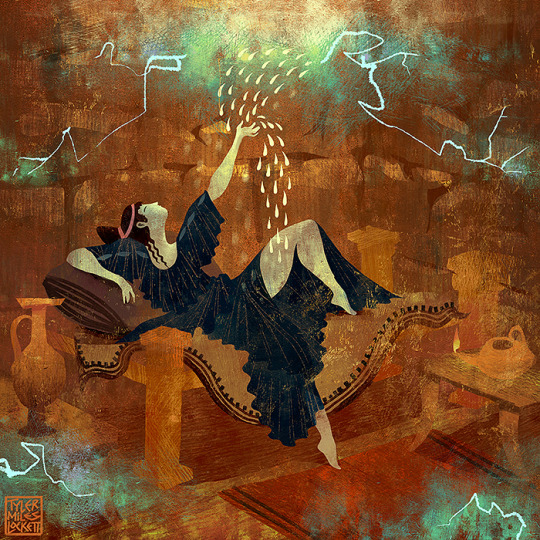
The Seduction of Danae, (#1 in my "Quest for the Gorgon Head" series)
King Akrisios of Argos receives an ominous warning from the oracle that his daughter, Danae, will give birth to a child that will slay the king. These pesky father slaying prophecies pop up again and again in Greek myth; Cronus being overthrown by his son (Zeus) and Zeus in turn being overthrown by his offspring with Metis.
So what does our King Akriosis do with his daughter? Well, he imprisons her into an underground Bronze chamber of course! keeping her and her womb far from any pesky suitor's libidos. But Zeus, visits Danae, and morphs into a gaseous cloud, penetrating into the cracks of the chamber, seducing Danae with warmth and wonder, pouring his favor upon her in the form of a golden rain. The symbolism is clear here, as rain fertilizing crops is standard symbolism for intercourse in Greek erotic poetry.
There is much debate through a modern lens at Zeus's conquests; is he raping or seducing? Well, He, and many other gods, do both. In certain tales, they seduce the willing, and in others, they rape the unwilling. With Danae, it was left open to my artistic interpretation. I decided that Danae, having been chained in a bronze dungeon cell by her own father, in her isolation and confinement, welcomes the deity and a child into her womb as a miracle. But when Danae gives birth to her son, a little boy she names Perseus, the King has a cruel plan for them both.
Like this art? It will be in my illustrated book with over 130 other full page illustrations coming in June to kickstarter. to get unseen free hi-hes art subscribe to my email newsletter
Follow my backerkit kickstarter notification page.
Thank you for supporting independent artists! 🤘❤️🏛😁
#greekmythology#greekgods#pjo#mythology#classics#classicscommunity#myths#ancientgreece#classicliterature#classicnovels#tylermileslockett
61 notes
·
View notes
Text
Because I'm incapable of seeing something that's shitty about Perseus without adding to my might-one-day-be Perseus fic, have some Polydektes;
Polydektes eyed his scribe, leaning forward and practically stabbing his hand towards the unfolded wax tablet in the man's hand.
"Well? What does it say?" He'd waited long enough for some upper hand, some way to proceed that didn't mean he'd have to do something so gauche as break into his brother's house with an armed contingent to escort his 'guest' out for her nuptials.
Guest, hah! Guesting anyone for nearly two decades by now would pale belief even among the most generous of hosts, and yet that was what his brother insisted the lovely Danae was, and what she insisted she was, nothing more, nothing less. And to be true, he did believe his brother hadn't made a concubine of the woman, despite that she was no less beautiful now than when she'd arrived on their island sixteen years ago. The woman was flawless, like a goddess among her mortal brethren, a single flower in an otherwise empty field of plain grass. She claimed she had a father who was alive and must be consulted before she married, yet refused to name him. Claimed she was a princess, and wouldn't willingly be made anyone's concubine, that it was an insult beyond life, and yet, again, she refused to name her supposed king - 'as long as my honourable and generous host is willing to keep me in his house'.
And his brother, his stupid, ridiculous, exhausting brother, had of course never wavered in his hospitality. His wife Clymene had, too, been frustratingly impeccable, apparently impervious to jealousy as well as bribery.
Now, none of that would matter any longer. Nearly three weeks ago, at the Festival of New Wine, he'd managed to approach his brother, Clymene, and the lovely Danae with her son without immediately being spotted, and overheard a most useful snatch of information. A clue to who Danae's father might be, as she'd spoken, with a quiet, aching sort of nostalgia that only made her lovelier and made him want to keep her so distracted in his bed her loveliness wouldn't yet be married by it, that she missed how Argos looked at this time of year. He'd been spotted moments later, pretending to no knowledge of what he'd overheard, but had sent a letter to the king of Argos only a couple days later.
If Danae was indeed the daughter of a king, and it was Argos she came from, unless she'd been married to the king of Argos but in that case he'd surely be directed to however her father was, he would now have what he needed to make Danae marry him. He was sure of it. The scribe cleared his throat, swallowing heavily as his gaze flicked between the tablet and Polydektes, finally bobbing his head.
"'My scepter bearing brother of Seriphos, greetings. Danae is indeed my daughter, born of my wife Eurydike and I, son of Abas. You have my permission to marry my daughter, taking your joy of her. The only bride price I would demand is that if she came to your island with a boy, who would have been about three years of age at the time, you have him killed, and kill any further sons you have by your new wife. The only reason I consigned my daughter to the elements to arrive at your island was due to an oracle, and I'm not about to risk it being fulfilled after it's finally being averted, by your gracious hand.' That's the end of the message, my lord."
Polydektes smiled, smacking the butt of the sceptre into the floor, ignoring his scribe and his pale-faced tension. The man was weak of stomach, but loyal.
Kill the boy?
Something he'd already been planning to do, though since Perseus had showed himself to be stronger than regular men when he'd been no more than twelve, the seemingly easy task had been decidedly more complicated since then. Being that strong, he was surely the son of a god - something which his grandfather had notably not mentioned. Perhaps Akrisios thought he would be weak enough to not dare such a deed, if he told the truth?
It couldn't be done simply, by mortals hands, even if they attempted to overwhelm the boy, definitely even stronger now just shy of twenty than he'd been at twelve, but there were other ways. Ways which would ensure the boy's father, if he was indeed a god, would have no reason to come after him, for it wasn't he who would have killed Perseus. And perhaps Perseus was just strong for no reason of divine ancestry, his grandfather putting child and mother in the chest that'd brought them to Serifos not for fear of the potentially divine father, but having enough conscience to not wish to kill kin directly.
It didn't matter. Whether Perseus' strength came from a divine father or merely blessed luck of human excellence, he'd take no chance. He'd simply find a way to trick the boy into some deed or another that'd be sure to kill him, and since he needed to plan for a wedding no matter what, he knew exactly how to go about it.
And if the old king of Argos thought he'd kill any sons he might get from the lovely Danae, he was gravely mistaken, whatever that oracle was. But then, what Akrisios wasn't told and wouldn't find out - until it was too late, if at all - wouldn't hurt him. Chuckling, Polydektes dismissed his scribe. Finally, this would be put to an end. Sixteen years after Danae's arrival, ten years of fruitless courting.
He'd show her what the place of a woman was, and she would come to enjoy it, for the life he could give her was no mean one. And she'd have new children, in time, to make up for the loss of her first one, ill-begotten as Perseus surely had been, no matter his father.
17 notes
·
View notes
Text
~~~~~Medusa~~~~~
~~~A Sea Deity~~~
~~Origin~~Ancient Greece
~~Dominion~~Wisdom, Feminine Blood Mysteries, Sexuality, Protecting.
~~Symbols~~Snakes, green, black & red, Hematite (Bloodstone).
~~Tarot Card~~Death, Queen of Swords
~~Workings~~Administer justice, protection, banishing, beauty, transformation, aiding in divination, awakening sexuality.
~~Other Titles~~Ruler of the Sea, The Ruler
~~Offerings~~Serpent figurines or images, snake skin, blood, red wine, coral ornaments (avoid buying real coral as it is endangered), sea water, sea salt, driftwood, green or black candles.
~~~Significant Dates~~~
~~Dark Moon: A potent time to tap into inner knowing.
~~Waning Moon: Associated with banishing and destruction.
~~Night Time / Darkness
~~~Medusa~~Who is she??~~~
A Serpent haired Gorgon whose gaze turned men to stone
Medusa was a Gorgon, a creature described as having a scaly head, protruding eyes and tusks. The introduction of the iconic serpentine hair wasn't introduced until much later. Medusa's parents descended from the primordial Greek earth Goddess Gaia, and Pontus, the personification of the sea. Phorkys, her father was called by ancient poet Homer 'The Old Man of the Sea' while her mother Keto was described as a sea monster. Their union produced monstrous triplets Stheno, Euryale and Medusa. These Gorgon sisters were hideous; to gaze upon them would petrify a person to death. The word Gorgon derives its meaning from the Greek word 'Gorgo', meaning 'grim one'. However, of these sisters Medusa was the only mortal. It could be inferred that Medusa's mortality gave her a human appearance in contrast to her frightening sisters. As we piece together the fragments of Greek mythology, we see discrepancies and variations like this. Ovid, the Roman writer described Medusa as a great beauty stripped of her charms in a vengeful curse from the Goddess Athena. He tells us that Medusa was raped by Poseidon at Athena's temple; in what seems an unreasonable act of retribution, Medusa is punished for the actions of another.
Although Medusa has a divine bloodline, she was not worshipped as a deity within Greek tradition but rather feared as a villain. Her main myth pertains to her death at the hands of Zeus's demigod son Perseus and is preserved in the writings of Homer and Ovid. In the ancient city of Argos, King Akrisios receives a prophecy that his death will be at the hands of the child birthed by his daughter Danae. The King tries to cheat his fate by locking Danae away so that she may never take a lover. No mortal prison can deter a God though, and Zeus soon enters Danae's chamber as a shower of gold. This unusual encounter leaves Danae pregnant. Unable to kill her, but happy to exile her to almost certain doom, King Akrisios locks Danae in a trunk and sends her adrift on the open water. Miraculously, mother and newborn son Perseus wash up alive and well on the shores of Seriphos where they are taken in by King Polydektes. Over the years, the relationship between Perseus and the King sours as Polydektes tries to force Danae to marry him. When the King eventually takes another to be his bride, Perseus promises the King the head of Medusa as a wedding gift. Goddess Athena, perhaps still holding a grudge against Medusa, aids Perseus on his quest. Athena explains that he must only look upon Medusa through a mirror, so that her gaze can't turn him to petrified stone. Perseus acquires an unbreakable sickle, Hades cap of invisibility, winged sandals and a shield polished to a mirror shine then sets off on his quest. Upon arrival, Perseus finds Medusa and her sisters slumbering in a jumble of bones and petrified bodies. Swiftly he decapitates the sleeping Gorgon and places her head in a sack. From her spilt blood, Pegasus the winged horse and Chrysaor are born, presumably fathered by Poseidon. Medusa's blood is said to have potent healing properties; Athena later gifts a vial of this blood to the healer Asclepius. Perseus carries Medusa's head with him, using it to turn his enemies to stone. Eventually he gives it to Athena, who places it upon her shield.
Alternative myths suggest that the once beautiful Medusa was a priestess of the virgin goddess Athena. Medusa was proud of her beauty, her flowing hair her most glorious feature. Poseidon, God of the Sea was enraptured by her, but she rejected all of his advances. Not to be denied, Poseidon took Medusa by force at the temple of Athena, desecrating a sacred place and robbing Medusa of her dignity. In anger, Athena punished Medusa by transforming her magnificent hair into living snakes. It seems unjust that Medusa paid the price for Poseidon's crime. However, some have reinterpreted the myth to infer that this curse was in fact a gift, intended so that Medusa would never be vulnerable again.
Medusa is strongly associated with the spiritual wisdom of serpentine energy, a recurring motif in human history. Dwelling in cracks and fissures beneath the earth, the snake is seen as an Underworld creature. A keeper of hidden knowledge, an emblem of creative and sexual energy. The shedding of its skin is a perfect metaphor for transformation and healing, stepping out of the old to emerge renewed and reborn. In this way, the serpent represents death as much as it symbolizes rebirth; its venomous fangs making it a fearsome predator.
In the myths of earlier cultures such as the Sumarian people of ancient Mesopotamia, the snake God Zu was a benevolent deity linked with fertility. Over time, the snake came to be vilified as evil and treacherous as can be seen with Eve's encounter in the Garden of Eden. This vilification can be viewed in Medusa's myth; punished for Poseidon's transgressions then hunted and beheaded as a trophy.
Coral was said to be the petrified blood of Medusa that had spilled into the sea
Greek myth portrayed the Goddess as the archetype of the 'devouring mother', a dark aspect of the feminine psyche that consumes and destroys. In spite of this, Medusa teaches us to own this shadow. No part of us should be denied, no matter how displeasing it may look at times, for it is necessary to have a fierce side if we are to protect our personal boundaries. If this dark aspect can be harnessed for empowerment and protection then it is valuable and worthy.
Medusa has experienced a revival as a patron of abuse survivors; she can be seen as a protectress of the vulnerable and called upon in defensive or banishment workings. She represents the unfairly demonized and avenges those who were denied justice.
Feminine sexuality, along with any sexuality not considered mainstream, has been repressed in the past, forced to conceal itself in shadow as something unsightly like the serpentine Goddess herself. For all that, Medusa encourages us to own our sexuality, to embrace the Kundalini energy so that we can release the creative, regenerative spirit that lies within us. She calls us to tap into our inner knowing, trusting the innate wisdom of our intuition. Medusa helps to heal our insecurities and embrace every aspect of ourselves. She asks us not to be afraid of disapproval, encouraging us to show our true face to the world.
~~~Devotion to Medusa~~~
Blessed is she with serpentine hair,
Immobilise foes with a deathly stare,
Your dark wisdom is misunderstood,
Embracing the shadow can be for the good,
Spirit of sea, the divine protector,
Beauty transformed to a frightening spectre,
Guardian to all that are shunned and rejected,
Returning the energy that's merely reflected.
Blessed Be!
3 notes
·
View notes
Photo
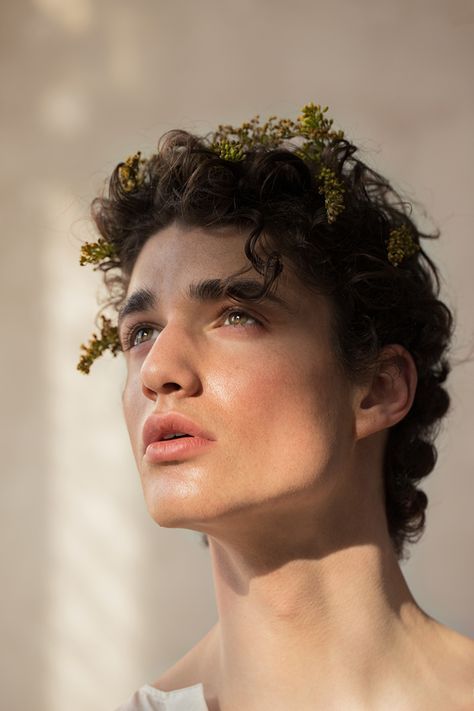
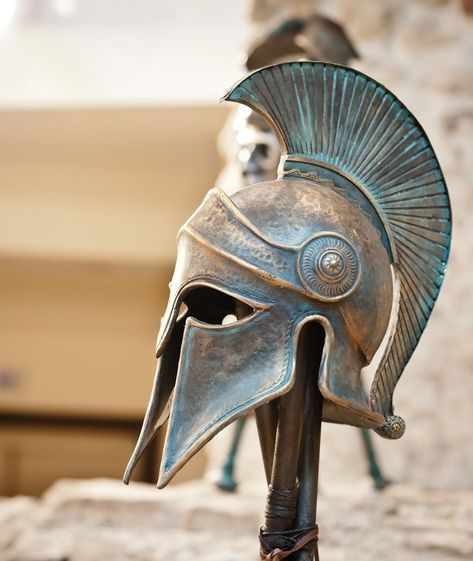

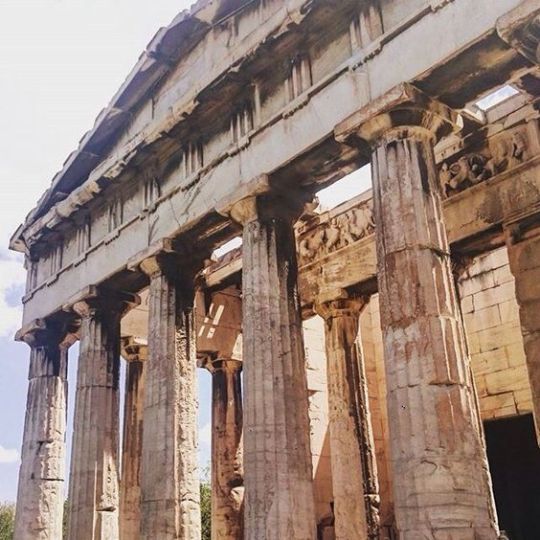
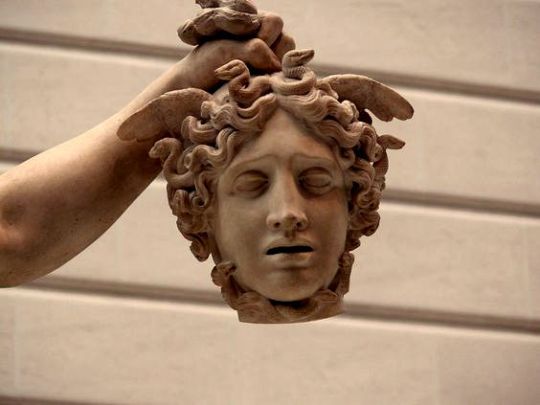
Περσευς
Perseus was one of the most celebrated heroes of Greek mythology.
He was the son of the Argive princess Danae who was locked away in a bronze chamber by her father Akrisios who lived in fear of a prophecy that he would one day be killed by her son. The god Zeus, however, infiltrated her prison in the guise of a golden shower and impreganted her. When Akrisios discovered the child, he placed the two in a chest and set them adrift at the sea. They were carried safely to the island of Seriphos where they were offered refuge by the kindly, fisherman Diktys.
When Perseus was fully grown, King Polydektes commanded he fetch the head of Medusa. With the help of the gods, Perseus obtained winged sandals, an invisible helm and a magical sword. He then sought out the ancient Graiai and stealing their single eye compelled them to reveal the location of the Gorgones. Perseus approached Medusa as she slept and beheaded her with eyes averted to avoid her petrifying visage.
On his journey back to Greece, Perseus came across the Ethiopian princess Andromeda chained to a rock as a sacrifice to a sea-monster. He slew the beast and brought her with him back to Greece as his bride.
Perseus was the ancestor of the royal houses of Mykenai, Elis, Sparta, Messenia, and distant Persia. His most famous descendant was Herakles.
#perseus#heroe#Greek Mythology#danae#akrisios#zeus#diktys#polydektes#medusa#graiai#gorgones#gorgon#greece#andromeda#mykene#herakles#myth#mythology#greek
425 notes
·
View notes
Text
Latin Names - Male: A
ABELARDUS: Latin form of German Abelard, meaning "noble strength."
ABRAHAMUS: Latin form of Hebrew Abraham, meaning "father of a multitude."
ACACIUS: Latin form of Greek Akakios, meaning "not evil."
ACCIUS: Roman Latin name meaning "of Acca."
ACHAICUS: Latin form of Greek Achaïkos, meaning "belonging to Achaia," a maritime region of northern Peloponnesus. In the bible, this is the name of a Christian who, together with Fortunatus and Stephanas, carried a letter from the Corinthians to Paul and back again.
ACHILL: Short form of Latin Achilles, possibly meaning "he who embodies the grief of the people."
ACHILLES: Contracted form of Latin Achilleus, possibly meaning "he who embodies the grief of the people." In mythology, this is the name of the greatest of Greek heroes who fought the Trojans, known for being the most handsome and the fleetest of foot at Troy, and for his love for his friend Patroclus.
ACHILLEUS: Latin form of Greek Akhilleus, possibly meaning "he who embodies the grief of the people."
ACRISIUS: Latin form of Greek Akrisios, probably meaning "locust." In mythology, this is the name of a king of Argos, the grandfather of Perseus.
ACTAEON: Latin form of Greek Aktaion, meaning "effulgence." In mythology, this is the name of a hunter who was torn to pieces by his own dogs. He was then transformed into a deer, thus himself becoming the hunted.
ACTEON: Variant spelling of Latin Actaeon, meaning "effulgence."
ADALRICUS: Latinized form of Old High German Adalric, meaning "noble ruler."
ADELFONSUS: Latinized form of Visigothic Adalfuns, meaning "noble and ready."
ADELPHUS: Latin form of Greek Adelphos, meaning "born of the same womb; sibling."
ADEODATUS: Ancient Roman Latin name meaning "given to God."
ADOLFUS: Latinized form of German Adolf, meaning "noble wolf." Used by the Swedish.
ADOLPHUS: Latinized form of German Adolf, meaning "noble wolf."
ADRASTUS: Latin form of Greek Adrastos, meaning "inescapable" or "not running away." In mythology, this is the name of a king of Argos.
ADRIANUS: Variant spelling of Latin Hadrianus, meaning "from Hadria."
ÆGIDIUS: Late Latin form of Greek Aegidios, meaning "kid; young goat" or "shield of goatskin."
ÆLIA: From Roman Ælianus, meaning "solar." This name is part of a puzzling alchemical inscription (Ælia Lælia Crispus) supposedly found in Bologna, which some have theorized is a representation of two beings, Ælia and Lælia, who are united in a single subject, Crispus "curly," with Ælia being "solar" from helios and Lælia being "lunar," while Crispus, a combination of both, is the basic substance (obvoluta intricata) from which all life was made, thus "curly," in reference to the hair of gossamer dryads which were said to be neither man nor woman but hermaphroditic.
ÆLIANUS: Roman family name, derived from Greek helios, meaning "sun."
ÆMILIANUS: A derivative of Roman Latin Æmilius, meaning "rival."
ÆMILIUS: Ancient Roman Latin name, meaning "rival."
AENEAS: Latin form of Greek Aineías, meaning "praiseworthy." In mythology, this is the name of a Trojan warrior who founded the Roman state.
ÆOLUS: Latin form of Greek Aiolos, meaning "sparkling; quick-shifting; quick-moving." In mythology, this is the name of a god of winds.
ÆSCHYLUS: Latin form of Greek Aischylos, meaning "shame."
ÆSON: Latin form of Greek Aison, possibly meaning "to be" or "that which is made." In mythology, this is the name of Jason's father.
ÆSOP: Latin form of Greek Aisopos, the name of the author of Æsop's Fables, said to be a Greek hump-backed slave of African descent; therefore, the name has taken on the meaning "hump-backed," but in Greek it means "Ethiop."
ÆTHER: Latin form of Greek Aither, meaning "bright, upper air." In mythology, this is the name of one of the first gods, the son of Erebus and Nyx. He is the god of the pure, upper air that only the gods breathe, as opposed to the gloomy, lower "aer" breathed by mortals.
ÆTIUS: Roman name derived from the Greek word ætos, meaning "eagle."
AGAPETUS: Latin form of Greek Agapetos, meaning "beloved."
AGAPITUS: Latin form of Greek Agapetos, meaning "beloved."
AGAPIUS: Latin form of Greek Agapios, meaning "divine love."
AGATHANGELUS: Latin form of Greek Agathangelos, meaning "good angel."
AGRIPPA (Агриппа): Latin form of Greek Agrippas, meaning "wild horse." In the New Testament bible, this is the name of the Herod Agrippa who ordered the execution of the apostle James, and the imprisonment of Peter. Compare with feminine Agrippa.
AHASUERUS (אֲחַשְׁוֵרוֹש): Latin form of Greek Xerxes, meaning "great warrior" or "lion-king." In the bible, this is the name of a king of Persia. His Hebrew name is Achashverosh.
AIGIDIUS: Latin form of Greek Aigidios, meaning "kid; young goat" or "shield of goatskin."
AIOLUS: Latin form of Greek Aiolos, meaning "sparkling; quick-shifting; quick-moving." In mythology, this is the name of the god of winds.
AJAX: Latin form of Greek Aias, meaning "mourner." In mythology, this is the name of a hero of the Trojan war, second only to Achilles in strength and bravery. He was also known as Telamonion Ajax (Ajax, son of Telamon), Greater Ajax, and Ajax the Great.
ALAIR: Latin form of French Alaire, meaning "joyful; happy."
ALARICUS: Latinized form of Visigothic Alaric, meaning "all-powerful; ruler of all."
ALBANUS: Latin family name meaning "like Albus," i.e. "white." It is related to the place name Alba which comes from the Celtic word Albion, used to refer to the whole island of Great Britain.
ALBERIC: Short form of Latin Albericus, meaning "elf ruler."
ALBERICUS: Latin form of German Alberich, meaning "elf ruler."
ALBERTUS: Latin form of Old High German Adalbert, meaning "bright nobility."
ALBINUS: Variant spelling of Roman Latin Albanus, meaning "like Albus," i.e. "white."
ALBUS: Latin name derived from the word albus, meaning "white, pale-skinned."
ALCAEUS: Latin form of Greek Alkaios, meaning "strength." In Greek mythology, this is the name of several characters, including a son of Perseus.
ALCANDER: Latin form of Greek Alkandros, meaning "strong." In mythology, this is the name of the man who chased the lawgiver Lycurgus out of a marketplace and put out one of his eyes.
ALCIMUS: Latin form of Greek Álkimos, meaning "valiant." In mythology, this is the name of the father of Mentor.
ALCINDER: Variant spelling of Latin Alcander, meaning "strong."
ALERIO: Latin name derived from the word alario, meaning "eagle."
ALEXANDRUS: Latin form of Greek Alexandros, meaning "defender of mankind."
ALEXIS: Unisex contracted form of Latin Alexius, meaning "defender."
ALEXIUS: Latin form of Greek Alexios, meaning "defender."
ALEXUS: Unisex contracted form of Latin Alexius, meaning "defender."
ALFONSUS: Latin form of Visigothic Adalfuns, meaning "noble and ready."
ALFREDUS: Variant spelling of Latin Alvredus, meaning "elf counsel."
ALMERICUS: Variant spelling of Latin Amaliricus, a form of Old German Amaliric, meaning "work-power."
ALOISIUS: Variant spelling of Latin Aloysius, meaning "famous warrior."
ALOYSIUS: Latin form of French Provençal Aloys, meaning "famous warrior."
ALPHAEUS: Latin form of Greek Halphaios, meaning "changing." In the bible, this is the name of the fathers of James and Levi.
ALPHEAUS: Variant spelling of Latin Alphaeus, meaning "changing."
ALPHEUS: Variant spelling of Latin Alphaeus, meaning "changing."
ALPHOEUS: Variant spelling of Latin Alphaeus, meaning "changing."
ALPHONSUS: Latin form of Visigothic Adalfuns, meaning "noble and ready."
ALPHONZUS: Variant spelling of Latin Alphonsus, meaning "noble and ready."
ALVINIUS: Latin form of Old High German Alwin, meaning "elf friend."
ALVREDUS: Latin form of Anglo-Saxon Ælfræd, meaning "elf counsel."
AMADEUS: Roman Latin name used by Mozart as a pen name, composed of the elements amare "to love" and Deus "God," hence "to love God."
AMALIRICUS: Latinized form of Old German Amaliric, meaning "work-power." This name is the source of many modern names; even the name America may have derived from it.
AMANDUS: Latin name derived from the word amanda, meaning "lovable."
AMANTIUS: Roman Latin name meaning "loving."
AMARANDUS: Latin form of Greek Amarandos, meaning "unfading."
AMARANTHUS: Latin form of Greek Amaranthos, meaning "unfading."
AMATUS: Latin form of French Amé, meaning "beloved."
AMBROSIANUS: Roman name derived from Latin Ambrosius, meaning "immortal."
AMBROSIUS: Latin form of Greek Ambrosios, meaning "immortal."
AMEDEUS: Variant spelling of Latin Amadeus, meaning "to love God."
AMERICUS: A derivative of Latin Amaliricus, meaning "work-power."
AMLETHUS: Latin form of Anglo-Saxon Amleþ, possibly meaning "heavy" or "the dullard."
AMLETUS: Either a Latin form of Old French Hamelet "tiny little village," or a variant spelling of Latin Amlethus, possibly meaning "heavy" or "the dullard."
AMOR: Latin name meaning "love." In Roman mythology, this is an epithet applied to Cupid.
AMPELIUS: Latin form of Greek Ampelios, meaning "vine."
AMPHION: Latin form of Greek Amphiōn, probably meaning "moving double" or "moving on both sides." In mythology, this is the name of a son of Zeus and Antiope.
ANACLETUS: Latin form of Greek Anakletos, meaning "called back; invoked."
ANASTASIUS: Latin form of Greek Anastasios, meaning "resurrection."
ANASTATIUS: Variant spelling of Latin Anastasius, meaning "resurrection."
ANASTIUS: Contracted form of Latin Anastasius, meaning "resurrection."
ANATOLIUS: Latin form of Greek Anatolios, meaning "east" and "sunrise."
ANDROCLES: Latin form of Greek Androkles, meaning "glory of a man/warrior."
ANDRONICUS: Latin form of Greek Andronikos, meaning "victory of a man/warrior." This is the name of many Byzantine and Trebizond emperors.
ANENCLETUS: Variant spelling of Latin Anacletus, meaning "called back; invoked."
ANGELICUS: Latin name derived from the word angelicus, meaning "angelic."
ANGELUS: Latin form of Greek Angelos, meaning "angel, messenger."
ANICETUS: Latin form of Greek Aniketos, meaning "unconquerable."
ANTIGONUS: Latin form of Greek Antigonos, meaning "against the ancestor."
ANTIPATER: Latin form of Greek Antipatros, meaning "like the father."
ANTONINUS: Roman name derived from older Latin Antonius, possibly meaning "invaluable."
ANTONIUS: Latin form of Greek Antonios, possibly meaning "invaluable."
APHRODISIUS: Latin form of Greek Aphrodisios, meaning "risen from the foam."
APOLLINARIS: Ancient Roman Latin name meaning "of Apollo."
APOLLO: Latin form of Greek Apollon, probably meaning "destroyer." In Greek mythology, this is the name of a god of archery, healing, light, poetry, prophecy, music, and the sun. He is the son of Zeus and Leto, and the twin brother of Artemis, goddess of the hunt and moon.
APOLLONIUS: Latin form of Greek Apollonios, meaning "of Apollo."
APPIUS: Latin Praenomen of several Romans, including Appius Claudius Sabinus Inregillensis, the founder of the clan of Claudia. He was born Attius Clausus, and became consul of Rome in 495 BCE. According to Livy, in his History of Rome, Appius was "harsh by nature," having an "innate love of tyranny." The clan name Appius/Attius may be related to the name of the eunuch god Attis, meaning "Papa."
AQUILA: Roman Latin name meaning "eagle." In the New Testament bible, this is the name of a Jew of Pontus and ally of Paul.
ARCADIUS: Latin form of Greek Arkadios, meaning "of Arcadia." The place name Arcadia was derived from the word arktos, meaning "bear."
ARCHELAUS: Latin form of Greek Archelaos, meaning "master of the people." In the bible, this is the name of a son of Herod the Great.
ARCHIPPUS: Latin form of Greek Archippos, meaning "master of horses."
ARGUS: Latin form of Greek Argos, meaning "bright, shining" and "swift." In mythology, this is the name of a giant who had a hundred eyes that were transferred to the peacock's tail after his death. This was also the name of Ulysses' dog who waited ten years for his return from the Trojan War.
ARIES: Latin name meaning "ram." The ram in the Aries constellation is probably the same ram from Greek mythology whose golden fleece was the quest of Jason and the Argonauts.
ARISTAEUS: Latin form of Greek Aristaios, meaning "excellence." In mythology, this is the name of the son of Apollo and a mortal woman. He was raised on ambrosia and made immortal by Gaia.
ARISTARCHUS: Latin form of Greek Aristarchos, meaning "best ruler." In the bible, this is the name of a companion of Paul. It is also the name of an asteroid and a crater on the Moon.
ARISTIDES: Latin form of Greek Aristeides, meaning "best physique."
ARISTOBULUS: Latin form of Greek Aristoboulos, meaning "best-counseling." In the bible, this is the name of a certain Christian.
ARISTOCLES: Latin form of Greek Aristokles, meaning "best glory."
ARISTODEMUS: Latin form of Greek Aristodemos, meaning "best of the people."
ARISTOTLE: Latin form of Greek Aristoteles, meaning "best purpose."
ARMINIUS: Latin form of German Hermann, meaning "army man." This name was borne by the Teutonic national leader Arminius the Cheruscan, mentioned by Tacitus.
ARNOLDUS: Latin form of Frankish German Arnwald, meaning "eagle power."
ARSENIUS: Latin form of Greek Arsenios, meaning "virile."
ARTEMIDORUS: Latin form of Greek Artemidoros, meaning "gift of Artemis."
ARTEMISIUS: Latin form of Greek Artemisios, meaning "safe and sound."
ARTORIUS: Latin form of Celtic Arthur, possibly meaning "bear-man." This is the first recorded form of Arthur's name that has been found.
ASCLEPIUS: Latin form of Greek Asklepios, possibly meaning "surgeon." In mythology, this is the name of a demigod who learned the secret of life and death from a serpent.
ATHAMUS: Latin form of Greek Athamas, meaning "rich harvest." In mythology, this is the name of the father of Phrixus.
ATHANASIUS: Latin form of Greek Athanasios, meaning "immortal."
ATILIUS: Variant spelling of the Roman Latin family name Attilius, possibly meaning "father."
ATTICUS: Roman Latin name meaning "from Attica."
ATTILIUS: Roman Latin family name, possibly ultimately from Teutonic Atta, meaning "father."
ATTIUS: From Roman Latin Attilius, possibly meaning "father."
AUGUST: Short form of Latin Augustus, meaning "venerable." In use by the English and Germans.
AUGUSTINUS: From Roman Latin Augustus, meaning "venerable."
AUGUSTUS: Ancient Roman Latin name meaning "venerable." Originally a title borne by the first Roman emperor, Octavian.
AULUS: Roman name, possibly derived from Etruscan Aule which is, unfortunately, of unknown meaning. Some sources connect it with Latin aula/olla, meaning "palace."
AURELIANUS: From Roman Latin Aurelius, meaning "golden."
AURELIUS: Roman name derived from Latin aureus, meaning "golden."
AURIEL: Latin name meaning "gold" or "golden."
AVITUS: Ancient Roman name meaning "ancestral."
0 notes
Text
Thessaly Central Greece ANCIENT GREEK COIN Collecting Guide
Guide to Ancient Greek Coins of Thessaly Central Greece
List of the cities in Thessaly which issued coins in ancient times and a collection of coins from the area
youtube
https://www.youtube.com/watch?v=7rjIAgU3coI
The goal of this guide is to share the information about the types of ancient Greek coins that were struck by the Greek towns of the area in central Greece known as Thessaly. With the list you can see below, you can use to search my store by clicking on the term, or printed out as a check-list to help you put together a coin collection from the area. With the video and the list of coins along with pictures and descriptions of them, you too, can become an expert in these types of coins. Some of the cities just issued bronze coins, others issued gold silver and bronze types.
The most comprehensive book on the subject is Handbook of Ancient Greek Coins Volume 4 by Oliver D. Hoover. The other book to get is the Volume I and Volume II of Ancient Greek Coins and Their Values by David R. Sear. You can also see pictures and descriptions of coins from Thessaly for research purposes at this research site, by scrolling to the section on Thessaly with much information about the coin types.
The most prominent town of ancient Thessaly was Larissa, which minted some of the most prolific coin types of that area. Many of the city’s coins featured a nymph and a horse. Many of the coins of ancient Thessaly featured horses. Thessaly issued coins into the Roman times, and the types are known as Greek Imperial/ Roman Provincial. Coins discussed in this video include those of Augustus, Claudius and Gallienus.
Click here to see all ancient coins of Thessaly
Click here to see the coins discussed in the video
Click here to visit my eBay coin shop
List of The Cities of Ancient Thessaly
Atrax
Demetrias
Dion
Ekkarra
Eureoioi
Eurymenai
Gomphi
Gonnos
Gyrton
Halos
Herakleia Trachinia
Homolion
Hypata
Iolkos
Kierion
Krannon
Lamia
Larissa
Larissa Kremaste
Meliboia
Melitaia
Methylion
Metropolis
Mopsion
Olosson
Orthos
Pagasai
Pelinna
Peuma
Phakion
Phalanna
Phaloria
Pharkadon
Pharos
Pharsalos
Pherai
Pherai, Teisiphon Tyrant of
Pherai, Alexander Tyrant of
Pierasia
Proerna
Rhizous
Skotoussa
The Ainians
The Magnetans
The Malians
The Oitaians
The Perrhaibans
The Thessalian League
Thebai Phthiotides
Trikka
Tripolis
Examples of Authentic Ancient Greek Coins of Thessaly
See the coins illustrated in the video here. It is great to see what these coins look like and get to appreciate the art and history of them.
LARISSA in THESSALY 356BC Silver Drachm Nymph Horse Ancient Greek Coin i47970
Greek city of Larissa in Thessaly
Silver Drachm 20mm (5.75 grams) Struck circa 356-320 B.C.
Reference: HGC 4, 453; BCD Thessaly II, lot 280
Pedigree: Ex BCD Collection with his original hand-written tag and photos of this coin
Head of nymph Larissa facing three-quarters left, wearing ampyx.
ΛAPI/ΣΑIΩN, Horse grazing right.This city was named after a local water nymph named Larissa. The story goes that the nymph drowned while playing ball on the banks of the Peneios River. In Greek mythology, the Greek hero Perseus accidentally killed his grandfather, King Akrisios of Argos when participating in the funeral games held in the city for nymph Larissa. The people of that city made their wealth from the rich agricultural area around the city and from breeding horses.
LARISSA in THESSALY 420BC Silver Drachm HERO vs BULL Ancient Greek Coin i47972
Greek city of Larissa in Thessaly
Silver Drachm 20mm (5.72 grams) Struck circa 420-400 B.C.
Reference: HGC 4, 420; BCD Thessaly II, lot 173-175 and 370.1; ANG Ashmolean 3860
Pedigree: Ex BCD Collection with his original hand-written tag and photos of this coin
Hero (Thessalos or Jason) wrestling a bull.
ΛAPI/ΣΑIΩN, Horse grazing right.This type references taurokathapsia (bull-wrestling) with the depiction of a hero wrestling the bull, which was a sport played at the Taureia games honoring Poseiodn Taureios. Jason was the father of Thessalos in a mythological tradition whom in turn was the ancestor of the entire Thessalian people.
Larissa in Thessaly 460BCObol Horse Lion Hydira Ancient Silver Greek Coin i46757
Greek city of Larissa in Thessaly
Silver Obol 12mm (0.72 grams) Struck circa 460-400 B.C.
Reference: BCD Thessaly II 358.1
Horse prancing right; above, head of lion right.
Larissa standing right, balancing hydria on raised knee; to left, lion’s head fountain right, from which water pours forth; Λ Α RI around from upper left; all within incuse square.
LARISSA in THESSALY 462BC Obol Bull Horse Ancient Silver Greek Coins i46360
Greek city of Larissa in Thessaly
Silver Obol 11mm (0.94 grams) Struck circa 462-460 B.C.
Reference: BCD Thessaly II 147; Liampi, Corpus 15i (V7/R9)
Head and neck of bull left, turning to face viewer.
ΛΑ (retrograde) downward to right, head and neck of bridled horse right; all within incuse square.
Larissa in Thessaly 350BC RARE Authentic Ancient Greek Coin Nymph Horse i42111
Greek city of Larissa in Thessaly
Bronze 18mm (7.42 grams) Struck 350-325 B.C.
Reference: Sear 2132 var., B.M.C. 7. 86.
Head of nymph Larissa three-quarter face to left, wearing necklace; hair confined by fillet
and floating loosely, with ampyx in front.
ΛΑΡΙΣΑIΩN. – Thessalian horseman right, holding spear, horse prancing; beneath, Σ.
LARISSA Thessaly THESSALIAN LEAGUE 196BC Athena Apollo Greek Coin i43487
Greek city of Larissa in Thessaly
under Thesssalian League
Bronze 19mm (6.61 grams) Struck 196-27 B.C.
Hippolochos, magistrate.
Reference: Rogers 21; SNG Copenhagen 315
Laureate head of Apollo right.
ΘEΣΣA/ΛΩN, Athena Itonia striding right, hurling spear held in her right hand, shield on her left arm; above spear; IΠΠ-OΛO; A to left; to right, P above I.
PHARSALOS in THESSALY 400BC Athena Horse Authentic Ancient Greek Coin i49251
Greek city of Pharsalos in Thessaly
Bronze 15mm (3.40 grams) Struck circa 400-344 B.C.
Reference: HGC 4, 654; Sear 2196; Rogers 485-487; BCD Thessaly II, 653, 666.2
Head of Athena left in close-fitting crested Attic helmet ornamented with figure of Skylla.
ΦΑΡΣ, Helmeted cavalryman charging right on horseback, brandishing flail upon which bird perches.One of the more important towns of Thessaly, Pharsalos was built on the northern slopes of Mt. Narthakios. It was the scene of Caesar’s famous victory over Pompey in 48 B.C.
PHARSALOS in THESSALY 400BC Athena Horseman Footman Ancient Greek Coin i49255
Greek city of Pharsalos in Thessaly
Bronze 21mm (9.17 grams) Struck circa 400-344 B.C.
Reference: HGC 4, 646; Sear 2193 var.; Rogers 503-504; BCD Thessaly II, 671.3-4
Head of Athena three-quarter face to left, wearing triple-crested Corinthian helmet.
ΦΑΡΣ, Helmeted cavalryman charging right on horseback, brandishing flail; bird perches on helmet; footman advancing right, behind, carrying flail over shoulder.
PHARSALOS in THESSALY 400BC Athena Horse Authentic Ancient Greek Coin i49216
Greek city of Pharsalos in Thessaly
Bronze 12mm (1.58 grams) Struck circa 400-344 B.C.
Reference: HGC 4, 655; Sear 2197; Weber 2912; BCD Thessaly I, lot 1286;
BCD Thessaly II, lots 649 and 654
Head of Athena in Attic helmet right adorned with Skylla.
ΦΑΡΣ, Head of horse right.
SKOTUSSA Thessaly400BC Hercules Horse Rare Ancient Silver Greek Coin i22382
Greek city of Skotussa in Thessaly
Silver Trihemiobol 12mm (1.00 grams) Struck 400-367 B.C.
Reference: Sear 2219 var.
Bearded head of Hercules right, wearing lion’s skin.
Forepart of horse right, left leg raised; Σ-KO in lower field.
Details about SKOTUSSA in THESSALY 300BC Ares Horse Authentic Ancient Greek Coin i49475
Greek city of Skotussa in Thessaly
Bronze 20mm (5.32 grams) Struck 300-200 B.C.
Reference: HGC 4, 615; Sear 2223
Head of Ares right, in close-fitting helmet ornamented with plume.
ΣKOTOYΣ / ΣAIΩN above and below horse prancing right.
Details about KRANNON in THESSALY 400BC Horseman Hydria Authentic Ancient Greek Coin i49156
Greek city of Krannon in Thessaly
Bronze 15mm (4.87 grams) Struck circa 400-344 B.C.
Reference: Sear 2073 var.; HGC 4, 385
Horseman galloping right.
Hydria, mounted on wheels.The city was near the source of the river Onchestos. People of Krannon held Poseidon in high regard. The city derived it’s name from the various springs in the area (called kranna in Aiolic Greek). The city had an abundance of sheep and horses grazing in the plains which brought it great wealth. In times of drought, they had a hydria on wheels which they paraded through the city accompanied by prayers to Apollo, which it was famous for. There was also a temple of Athena and Asclepius in the city.
Details about Perrhaiboi in Thessaly 450BC Athena Horse Ancient Greek Silver Coin i46721
Greek city of Perrhaiboi in Thessaly
Silver Obol 13mm (0.78 grams) Struck circa 450-400 B.C.
Reference: BCD Thessaly II 551.1
Horse prancing right.
Π–E–P–A, Athena Itonia, holding spear, aegis over arm, advancing right within incuse square.
Details about Larissa Kremaste in Thessaly 300BC ACHILLES Troy Hero Ancient Greek Coin i49349
Greek city of Larissa Kremaste in Thessaly
Bronze Trichalkon 19mm (5.34 grams) Struck circa 300-200 B.C.
Reference: HGC 4, 13; BCD Thessaly II, 403
Head of Achilles left.
ΛΑΡΙ, Thetis riding hippocamp left, charring shield.Situated in the south of Thessaly, Larissa Kremaste was built on a height, hence its name. It was taken by Demetrios Poliorketes in 302 B.C., during his invasion of Thessaly. The myth goes that Achilles, the tragic hero of the Trojan war was born in the city and ruled a port of it’s dominions. Larissa Kremaste was also the city that Perseus visited on his exile from Argos. Thetis was the mother of Achilles, who is shown on coins from the city to be delivering weapons to him that were forged by the smith god, Hephaistos.
Details about MOPSION Thessaly 350BC MOPSUS v CENTAUR RARE Authentic Ancient Greek Coin i46547
Greek city of Mopsion in Thessaly
Bronze Trichalkon 22mm (8.53 grams) Struck circa 2nd half of the 4th century B.C.
Reference: Sear 2154
Head of Zeus three-quarter face to right; thunderbolt in field to right.
ΜΟΨEIΩΝ, The Lapith Mopsons, naked, standing facing, wielding club about to strike Centaur rearing left, holding boulder over head with both hands.
Details about Greek city of Perrhaiboi in Thessaly Authentic Ancient Coin 2ndCenBC Zeus i42044
Greek city of Perrhaiboi in Thessaly
Bronze Trichalkon 22mm (6.35 grams) Struck Late 2nd to early 1st century B.C.
Reference: Rogers 440; SNG Copenhagen 197; BCD Thessaly II 561; SNG Alpha bank 194ff
Laureate and bearded head of Zeus right.
ΠEPPAIBΩN, Hera, diademed and draped, seated right on backless throne, holding long scepter with her right and resting her left on her knee.
Details about GYRTON in THESSALY 400BC Zeus Cult Horse Authentic Ancient Greek Coin i37414
Greek city of Gyrton in Thessaly
Bronze 20mm (6.86 grams) Struck 400-344 B.C.
Reference: Sear 2089; B.M.C. 7.5
Laureate head of Zeus left.
ΓΥΡΤΩΝΙΟΝ, Horse trotting left; ΠM monogram below.
Details about PHALANNA in THESSALY 350BC Ares Nymph Authentic Ancient Greek Coin i49209
Greek city of Phalanna in Thessaly
Bronze 17mm (4.06 grams) Struck circa 350-325 B.C.
Reference: HGC 4, 175; Sear 2180; BCD Thessaly I, lot 1255; BCD Thessaly II, lots 578-580 and 591 3-8
Head of Ares right.
ΦΑΛΑΝΝΑΙΩΝ, Head of nymph Phalanna right, hair in sakkos.
Details about PHAKION in THESSALY 350BC Persephone Horseman RARE Ancient Greek Coin i49477
Greek city of Phakion in Thessaly
Bronze 19mm (5.73 grams) Struck circa 300-200 B.C.
Reference: HGC 4, 542 (R1); Sear 2176; Papevangelou 1996, nos. 1-42; BCD Thessaly I, lot 1249; BCD Thessaly II, lot 566; B.M.C. 7.1,2
Head of Persephone right, wreathed with grain.
ΦΑΚΙΑΣΤΩΝ, Horseman trotting right, right hand raised.
HALOS in THESSALY 302BC Zeus Phrixus on GOLDEN Ram RARE Greek Coin i49230
Greek city of Halos in Thessaly
Bronze 14mm (1.40 grams) Struck circa 302-265 B.C.
Reference: HGC 4, 8 (R1); BCD Thessaly II, lot 86.2
Laureate head of Zeus right.
AΛΕΩN, Phrixos riding ram right.Where Halos was originally located is unknown, however it is known that to have been located in the northern Achaia Phthiotis and overlooked Crocus Field. The myth of the city starts at the Halean temple of Zeus Lpahystios where the twins Helle and Phrixos were to be sacrificed, when a golden-fleeced flying ram was sent to rescue them by their mother, the nymph Nephele. King Athamas of Boiotia, was the father of Helle and Phrixos and was believed to have been the founder of the city. At the end of the Third Sacred War, in 346 B.C. the city was destroyed by the Macedonian general Parmenion. In 302 B.C. the city was re-founded, but this time closer to the sea coast by either Kassander or his rival Demetrios Poliorketes, rivals for the Macedonian throne. By around 265 B.C. the city was abandoned ostensibly due to a bad earthquake.
Greek city of Pelinna in Thessaly
Bronze 15mm (2.86 grams) Struck circa 400-344 B.C.
Reference: HGC 4, 284; Sear 2166 var. (horseman right)
Helmeted cavalryman charging left on horseback, spearing fallen hoplite.
ΠEΛΛINAEI, Thessalian peltast advancing lef, brandishing javelin and holding shield and javelin.
Greek city of Demetrias in Thessaly
Federal Coinage of The Magnetes
Bronze 20mm (6.20 grams) Struck 196-146 B.C.
Reference: Sear 2138; B.M.C. 7.11
Laureate head of Zeus left.
ΜΑΓΝΗΤΩΝ, Centaur standing right, right hand held before him, holding branch in left; plough to left, HΔ monogram below.
Details about LAMIA in THESSALY 325BC Athena Philoktetes Trojan War Archer Greek Coin i49224
Greek city of Lamia in Thessaly
Issuing in the name of the Malians (also known as the Malienses)
Bronze Chalkous 15mm (1.50 grams) Struck circa 325-300 B.C.
Reference: Sear 2142; Georgiou, Mint 16; Rogers (Malia) 384; BCD Thessaly II 125; HGC 4, 106
Helmeted head of Athena right.
MAΛIEΩ, Philoktetes right, shooting arrow at bird falling to right; quiver to lower right.
Details about PEUMA in THESSALY 302BC Achilles Trojan War Troy Hero Ancient Greek Coin i49485
Greek city of Peuma in Thessaly
Bronze Chalkous 12mm (1.88 grams) Struck circa 302-286 B.C.
Reference: Rogers 442; BCD Thessaly II 565
Wreathed head of Achilles right.
ΠEYMATIΩN around AX monogram; Phrygian helmet to right.
Details about Pherai in Thessaly TYRANT Teisiphon 358BC Bull Horse Ancient Greek Coin i49345
Greek city of Pherai in Thessaly
Teisiphon – Tyrant of Pherai: 358-354 B.C.
Bronze Chalkous 15mm (2.22 grams)
Reference: HGC 4; 585; Sear 2214; Rogers 530; BCD Thesssaly I, lot 1316; BCD Thessaly II, lots 709-710
Forepart of bull right, head facing.
ΤΕΙΣΙΦΟΝΟΥ, forepart of horse prancing right.Teisiphon was the brother of Thebe who was the wife of the previous tyrant, Alexander. Thebe opened the door to Alexander’s bedchamber. Teisiphons two brothers held Alexander down while Teisiphon finished him off with his sword. Through bribery, Teisiphon was able to get the support of Alexander’s mercenaries, which they used to destroy the political opposition to his reign. Then he became the tyrant of the city, although he may have been a puppet of his sister Thebe. Teisiphon was succeeded by two further tyrants, whom were eventually overthrown by Philip II, king of Macedon.Situated west of Mt. Pelion, Pherai was the second city of Thessaly, after Larissa. In the 4th Century B.C. its tyrants extended their power over most of the region.
Details about AUGUSTUS 27BC Thessaly Koinon ATHENA Authentic Ancient Roman Coin RARE i47217
Augustus – Roman Emperor: 27 B.C. – 14 A.D.
Bronze Diassarion 22mm (10.46 grams) of Thessaly, Koinon of Thessaly
Megalokles, strategos, and Arist–, tamias(?)
Reference: Burrer Em. 2, Series 2, 69 (A17/R58); BCD Thessaly I 1398; RPC I 1428
ΣEBAΣ-TOΣ ΘEΣΣAΛΩN, laureate head right
ΣTPATHΓOY M-EΓAΛOKΛEOYΣ APIΣT, Athena Itonia striding right, hurling spear held in right hand, shield on her left arm; monogram to right.
Details about CLAUDIUS 41AD Koinon of Thessaly Thessalian League Athena Roman Coin i42048 Rare
Claudius – Roman Emperor: 41-54 A.D. –
Bronze Diassarion 24mm (7.57 grams) of THESSALY, Koinon of Thessaly
Antigonos, strategos
Reference: RPC 1435-1436; Burrer Em. 1, Series 3, Grp. 1a, 43 corr. (A15/R34; rev. legend)
ΘΕΣΣΑΛΩΝ ΣΕΒΑΣΤΗΩΝ, Bare head of Augustus right.
ΑΝΤΙΓΟΝΟΥ ΣΤΡΑΤΗΓΟΥ, Athena Itonia striding right, hurling spear held in her right hand, shield on her left arm; monogram in left field.
Details about GALLIENUS 253AD Koinon of Thessaly Athena Authentic Ancient Roman Coin i49342
Gallienus – Roman Emperor: 253-268 A.D. –
Bronze Tetrassarion 25mm (10.33 grams) of Koinon of Thessaly in Thessaly
Reference: Sear GIC 4530 var.; Burrer, MA–G 53; BCD Thessaly II 991.2-991.3
AVT. ΓΑΛΛΗNΟC ΑVΓ, Radiate, draped, and cuirassed bust right.
KOINON ΘЄΣΣΑΛΩΝ, Athena Itonia striding right, hurling spear with right hand, shield on left arm; Δ (mark of value) to left.
Guide to Ancient Greek Coins of Thessaly Central Greece and Collection for Sale by Expert on eBay
Download this article by right-clicking here and selecting save as
Article by Ilya Zlobin, world-renowned expert numismatist, enthusiast, author and dealer in authentic ancient Greek, ancient Roman, ancient Byzantine coins and beyond.
For more great articles and videos on ancient coins, visit, http://www.trustedancientcoins.com/articles/
See More Here: Thessaly Central Greece ANCIENT GREEK COIN Collecting Guide
Cool blog post about ancient coin collecting. World-renowned numismatic expert posted this to teach.
from Authentic Ancient Greek Roman Biblical World Coins for Sale You Can Buy on eBay https://authenticancientgreekromancoinsforsaleyoubuyonline.wordpress.com/2017/10/17/thessaly-central-greece-ancient-greek-coin-collecting-guide/
via https://authenticancientgreekromancoinsforsaleyoubuyonline.wordpress.com
http://belladearcy.blogspot.com/2017/10/thessaly-central-greece-ancient-greek.html
from Blogger http://nathanropler.blogspot.com/2017/10/thessaly-central-greece-ancient-greek.html
0 notes
Photo

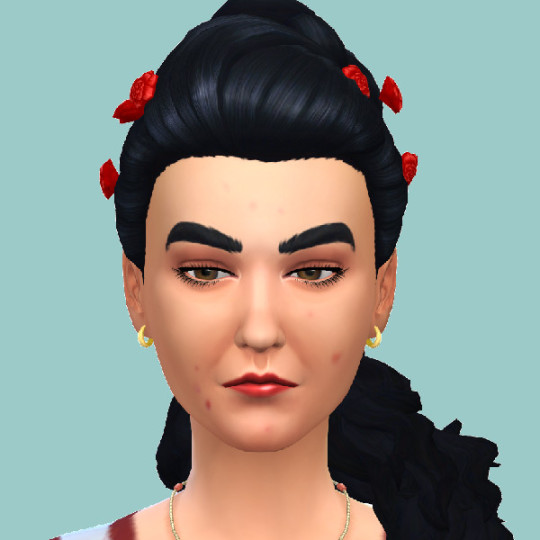



Queen Laonome Akrisiou (Amphytriona) - DECEASED
GENDER - Female
AGE - Adult
Queen of Selinódasos
ASPIRATION - Renaissance Sim
TRAITS: Proper, Childish, Goofball
SIGN: Gemini
PARENTS - King Radhamanthos and Queen Alkmini
PARTNER - King Akrisios
CHILDREN - Euthalia, Nikh, Philokratis,
Download: King Radhamanthos and the Royal family
Story: Once Upon A Time - The first ones
Family tree: The first ones
ADULT: Life has had an impact on Laonome, as it has on most of us. She enjoy her children, seeing them grow up and prosper, but she also misses the fuzz and buzz of Manthos Castle. She is quite involved int the politics in her new kingdom, and there are visits to look forward to of course, but, you know, it’s not the same. Don’t misunderstand, she is not unhappy! But she is not really happy either.
YOUNG ADULT: She married early - thanks to his mother's ambitious plan - and even if she was not thrilled in the beginning, it worked out quite well for her. The Akrisios Castle was much more relaxed and informal than the vast and impersonal Manthos Palace. She enjoyed taking care of her own children, and even having direct contact with the animals on the castle farm. Who would have thought that?
TEEN: She has inherited her mother's beauty, but not her diplomatic finesse. But to be just, she is still young, and she might learn. At the moment she seems very immature and her actions are not very carefully considered. She has her own knack for annoying people, probably something she learned from growing up with two brothers.
#Story character#Chapter 6#Laonome Amphytriona#Royal Family#Generation 2#side character#Once Upon A Time#Early Civilization#Laonome Akrisiou#Princess Laonome#Queen Laonome#Royal Family of Manthos#Royal Family of Selinódasos#Princess of Manthos#Queen of Selinódasos#KyriaT#deceased
2 notes
·
View notes
Text
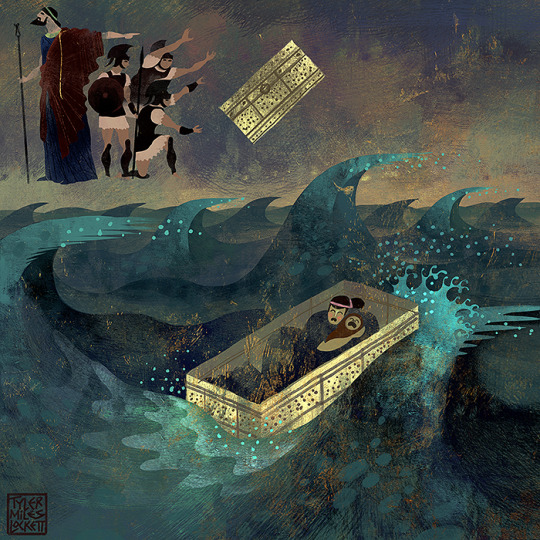
Castaways (#2 in my Quest for the Gorgon head series)
After the miracualous conception, Danae gives birth to a demi-god son she names Perseus. King Akrisios, not believing the child to have been born of Zeus, and to punish her, places her and the child into a chest and casts them into the sea. the pair find safe passage to the shore of Seriphos. Here they are rescued upon the coast by a fisherman, Diktys, who raises Perseus. But Diktys brother is king Polydektes, who, becoming enamoured with Danae, seeks to remove the protective Perseus from his path of desire.
What I find fascinating about this plot point is it being an early example of the "child surviving sure death to fulfill destiny as the chosen one" archetype. From the Book of Exodus (600 B.C.) we have a similar structure of abandonment, rescue from water, and adoption by royalty. In Ancient Egypt, the Pharaoh ordered the slaughter of Israelite children, so Moses' mother placed him within a basket, and cast him off into the Nile, to later be discovered and adopted by the Egyptian royal family.
It also brings to mind another similar structure used by Sophocles in his famous tragedy "Oedipus Rex." (429.B.C.) Queen Jocasta, hearing a prophecy that her son will kill his father (her husband) gives the baby away to a shepherd to leave out exposed on a mountain side, but the shepherd saves the baby's life, thus allowing Odepis to live on to fulfill the prophecy. But that's a tale for another time.
Like this art? It will be in my illustrated book with over 130 other full page illustrations coming in June to kickstarter. to get unseen free hi-hes art subscribe to my email newsletter
Follow my backerkit kickstarter notification page.
Thank you for supporting independent artists! 🤘❤️🏛😁
#greekmythology#greekgods#pjo#mythology#classics#classicscommunity#myths#ancientgreece#classicliterature#classicnovels#tylermileslockett#greekmyths
45 notes
·
View notes
Text
Thessaly Central Greece ANCIENT GREEK COIN Collecting Guide
Guide to Ancient Greek Coins of Thessaly Central Greece
List of the cities in Thessaly which issued coins in ancient times and a collection of coins from the area
youtube
https://www.youtube.com/watch?v=7rjIAgU3coI
The goal of this guide is to share the information about the types of ancient Greek coins that were struck by the Greek towns of the area in central Greece known as Thessaly. With the list you can see below, you can use to search my store by clicking on the term, or printed out as a check-list to help you put together a coin collection from the area. With the video and the list of coins along with pictures and descriptions of them, you too, can become an expert in these types of coins. Some of the cities just issued bronze coins, others issued gold silver and bronze types.
The most comprehensive book on the subject is Handbook of Ancient Greek Coins Volume 4 by Oliver D. Hoover. The other book to get is the Volume I and Volume II of Ancient Greek Coins and Their Values by David R. Sear. You can also see pictures and descriptions of coins from Thessaly for research purposes at this research site, by scrolling to the section on Thessaly with much information about the coin types.
The most prominent town of ancient Thessaly was Larissa, which minted some of the most prolific coin types of that area. Many of the city’s coins featured a nymph and a horse. Many of the coins of ancient Thessaly featured horses. Thessaly issued coins into the Roman times, and the types are known as Greek Imperial/ Roman Provincial. Coins discussed in this video include those of Augustus, Claudius and Gallienus.
Click here to see all ancient coins of Thessaly
Click here to see the coins discussed in the video
Click here to visit my eBay coin shop
List of The Cities of Ancient Thessaly
Atrax
Demetrias
Dion
Ekkarra
Eureoioi
Eurymenai
Gomphi
Gonnos
Gyrton
Halos
Herakleia Trachinia
Homolion
Hypata
Iolkos
Kierion
Krannon
Lamia
Larissa
Larissa Kremaste
Meliboia
Melitaia
Methylion
Metropolis
Mopsion
Olosson
Orthos
Pagasai
Pelinna
Peuma
Phakion
Phalanna
Phaloria
Pharkadon
Pharos
Pharsalos
Pherai
Pherai, Teisiphon Tyrant of
Pherai, Alexander Tyrant of
Pierasia
Proerna
Rhizous
Skotoussa
The Ainians
The Magnetans
The Malians
The Oitaians
The Perrhaibans
The Thessalian League
Thebai Phthiotides
Trikka
Tripolis
Examples of Authentic Ancient Greek Coins of Thessaly
See the coins illustrated in the video here. It is great to see what these coins look like and get to appreciate the art and history of them.
LARISSA in THESSALY 356BC Silver Drachm Nymph Horse Ancient Greek Coin i47970
Greek city of Larissa in Thessaly
Silver Drachm 20mm (5.75 grams) Struck circa 356-320 B.C.
Reference: HGC 4, 453; BCD Thessaly II, lot 280
Pedigree: Ex BCD Collection with his original hand-written tag and photos of this coin
Head of nymph Larissa facing three-quarters left, wearing ampyx.
ΛAPI/ΣΑIΩN, Horse grazing right.This city was named after a local water nymph named Larissa. The story goes that the nymph drowned while playing ball on the banks of the Peneios River. In Greek mythology, the Greek hero Perseus accidentally killed his grandfather, King Akrisios of Argos when participating in the funeral games held in the city for nymph Larissa. The people of that city made their wealth from the rich agricultural area around the city and from breeding horses.
LARISSA in THESSALY 420BC Silver Drachm HERO vs BULL Ancient Greek Coin i47972
Greek city of Larissa in Thessaly
Silver Drachm 20mm (5.72 grams) Struck circa 420-400 B.C.
Reference: HGC 4, 420; BCD Thessaly II, lot 173-175 and 370.1; ANG Ashmolean 3860
Pedigree: Ex BCD Collection with his original hand-written tag and photos of this coin
Hero (Thessalos or Jason) wrestling a bull.
ΛAPI/ΣΑIΩN, Horse grazing right.This type references taurokathapsia (bull-wrestling) with the depiction of a hero wrestling the bull, which was a sport played at the Taureia games honoring Poseiodn Taureios. Jason was the father of Thessalos in a mythological tradition whom in turn was the ancestor of the entire Thessalian people.
Larissa in Thessaly 460BCObol Horse Lion Hydira Ancient Silver Greek Coin i46757
Greek city of Larissa in Thessaly
Silver Obol 12mm (0.72 grams) Struck circa 460-400 B.C.
Reference: BCD Thessaly II 358.1
Horse prancing right; above, head of lion right.
Larissa standing right, balancing hydria on raised knee; to left, lion’s head fountain right, from which water pours forth; Λ Α RI around from upper left; all within incuse square.
LARISSA in THESSALY 462BC Obol Bull Horse Ancient Silver Greek Coins i46360
Greek city of Larissa in Thessaly
Silver Obol 11mm (0.94 grams) Struck circa 462-460 B.C.
Reference: BCD Thessaly II 147; Liampi, Corpus 15i (V7/R9)
Head and neck of bull left, turning to face viewer.
ΛΑ (retrograde) downward to right, head and neck of bridled horse right; all within incuse square.
Larissa in Thessaly 350BC RARE Authentic Ancient Greek Coin Nymph Horse i42111
Greek city of Larissa in Thessaly
Bronze 18mm (7.42 grams) Struck 350-325 B.C.
Reference: Sear 2132 var., B.M.C. 7. 86.
Head of nymph Larissa three-quarter face to left, wearing necklace; hair confined by fillet
and floating loosely, with ampyx in front.
ΛΑΡΙΣΑIΩN. – Thessalian horseman right, holding spear, horse prancing; beneath, Σ.
LARISSA Thessaly THESSALIAN LEAGUE 196BC Athena Apollo Greek Coin i43487
Greek city of Larissa in Thessaly
under Thesssalian League
Bronze 19mm (6.61 grams) Struck 196-27 B.C.
Hippolochos, magistrate.
Reference: Rogers 21; SNG Copenhagen 315
Laureate head of Apollo right.
ΘEΣΣA/ΛΩN, Athena Itonia striding right, hurling spear held in her right hand, shield on her left arm; above spear; IΠΠ-OΛO; A to left; to right, P above I.
PHARSALOS in THESSALY 400BC Athena Horse Authentic Ancient Greek Coin i49251
Greek city of Pharsalos in Thessaly
Bronze 15mm (3.40 grams) Struck circa 400-344 B.C.
Reference: HGC 4, 654; Sear 2196; Rogers 485-487; BCD Thessaly II, 653, 666.2
Head of Athena left in close-fitting crested Attic helmet ornamented with figure of Skylla.
ΦΑΡΣ, Helmeted cavalryman charging right on horseback, brandishing flail upon which bird perches.One of the more important towns of Thessaly, Pharsalos was built on the northern slopes of Mt. Narthakios. It was the scene of Caesar’s famous victory over Pompey in 48 B.C.
PHARSALOS in THESSALY 400BC Athena Horseman Footman Ancient Greek Coin i49255
Greek city of Pharsalos in Thessaly
Bronze 21mm (9.17 grams) Struck circa 400-344 B.C.
Reference: HGC 4, 646; Sear 2193 var.; Rogers 503-504; BCD Thessaly II, 671.3-4
Head of Athena three-quarter face to left, wearing triple-crested Corinthian helmet.
ΦΑΡΣ, Helmeted cavalryman charging right on horseback, brandishing flail; bird perches on helmet; footman advancing right, behind, carrying flail over shoulder.
PHARSALOS in THESSALY 400BC Athena Horse Authentic Ancient Greek Coin i49216
Greek city of Pharsalos in Thessaly
Bronze 12mm (1.58 grams) Struck circa 400-344 B.C.
Reference: HGC 4, 655; Sear 2197; Weber 2912; BCD Thessaly I, lot 1286;
BCD Thessaly II, lots 649 and 654
Head of Athena in Attic helmet right adorned with Skylla.
ΦΑΡΣ, Head of horse right.
SKOTUSSA Thessaly400BC Hercules Horse Rare Ancient Silver Greek Coin i22382
Greek city of Skotussa in Thessaly
Silver Trihemiobol 12mm (1.00 grams) Struck 400-367 B.C.
Reference: Sear 2219 var.
Bearded head of Hercules right, wearing lion’s skin.
Forepart of horse right, left leg raised; Σ-KO in lower field.
Details about SKOTUSSA in THESSALY 300BC Ares Horse Authentic Ancient Greek Coin i49475
Greek city of Skotussa in Thessaly
Bronze 20mm (5.32 grams) Struck 300-200 B.C.
Reference: HGC 4, 615; Sear 2223
Head of Ares right, in close-fitting helmet ornamented with plume.
ΣKOTOYΣ / ΣAIΩN above and below horse prancing right.
Details about KRANNON in THESSALY 400BC Horseman Hydria Authentic Ancient Greek Coin i49156
Greek city of Krannon in Thessaly
Bronze 15mm (4.87 grams) Struck circa 400-344 B.C.
Reference: Sear 2073 var.; HGC 4, 385
Horseman galloping right.
Hydria, mounted on wheels.The city was near the source of the river Onchestos. People of Krannon held Poseidon in high regard. The city derived it’s name from the various springs in the area (called kranna in Aiolic Greek). The city had an abundance of sheep and horses grazing in the plains which brought it great wealth. In times of drought, they had a hydria on wheels which they paraded through the city accompanied by prayers to Apollo, which it was famous for. There was also a temple of Athena and Asclepius in the city.
Details about Perrhaiboi in Thessaly 450BC Athena Horse Ancient Greek Silver Coin i46721
Greek city of Perrhaiboi in Thessaly
Silver Obol 13mm (0.78 grams) Struck circa 450-400 B.C.
Reference: BCD Thessaly II 551.1
Horse prancing right.
Π–E–P–A, Athena Itonia, holding spear, aegis over arm, advancing right within incuse square.
Details about Larissa Kremaste in Thessaly 300BC ACHILLES Troy Hero Ancient Greek Coin i49349
Greek city of Larissa Kremaste in Thessaly
Bronze Trichalkon 19mm (5.34 grams) Struck circa 300-200 B.C.
Reference: HGC 4, 13; BCD Thessaly II, 403
Head of Achilles left.
ΛΑΡΙ, Thetis riding hippocamp left, charring shield.Situated in the south of Thessaly, Larissa Kremaste was built on a height, hence its name. It was taken by Demetrios Poliorketes in 302 B.C., during his invasion of Thessaly. The myth goes that Achilles, the tragic hero of the Trojan war was born in the city and ruled a port of it’s dominions. Larissa Kremaste was also the city that Perseus visited on his exile from Argos. Thetis was the mother of Achilles, who is shown on coins from the city to be delivering weapons to him that were forged by the smith god, Hephaistos.
Details about MOPSION Thessaly 350BC MOPSUS v CENTAUR RARE Authentic Ancient Greek Coin i46547
Greek city of Mopsion in Thessaly
Bronze Trichalkon 22mm (8.53 grams) Struck circa 2nd half of the 4th century B.C.
Reference: Sear 2154
Head of Zeus three-quarter face to right; thunderbolt in field to right.
ΜΟΨEIΩΝ, The Lapith Mopsons, naked, standing facing, wielding club about to strike Centaur rearing left, holding boulder over head with both hands.
Details about Greek city of Perrhaiboi in Thessaly Authentic Ancient Coin 2ndCenBC Zeus i42044
Greek city of Perrhaiboi in Thessaly
Bronze Trichalkon 22mm (6.35 grams) Struck Late 2nd to early 1st century B.C.
Reference: Rogers 440; SNG Copenhagen 197; BCD Thessaly II 561; SNG Alpha bank 194ff
Laureate and bearded head of Zeus right.
ΠEPPAIBΩN, Hera, diademed and draped, seated right on backless throne, holding long scepter with her right and resting her left on her knee.
Details about GYRTON in THESSALY 400BC Zeus Cult Horse Authentic Ancient Greek Coin i37414
Greek city of Gyrton in Thessaly
Bronze 20mm (6.86 grams) Struck 400-344 B.C.
Reference: Sear 2089; B.M.C. 7.5
Laureate head of Zeus left.
ΓΥΡΤΩΝΙΟΝ, Horse trotting left; ΠM monogram below.
Details about PHALANNA in THESSALY 350BC Ares Nymph Authentic Ancient Greek Coin i49209
Greek city of Phalanna in Thessaly
Bronze 17mm (4.06 grams) Struck circa 350-325 B.C.
Reference: HGC 4, 175; Sear 2180; BCD Thessaly I, lot 1255; BCD Thessaly II, lots 578-580 and 591 3-8
Head of Ares right.
ΦΑΛΑΝΝΑΙΩΝ, Head of nymph Phalanna right, hair in sakkos.
Details about PHAKION in THESSALY 350BC Persephone Horseman RARE Ancient Greek Coin i49477
Greek city of Phakion in Thessaly
Bronze 19mm (5.73 grams) Struck circa 300-200 B.C.
Reference: HGC 4, 542 (R1); Sear 2176; Papevangelou 1996, nos. 1-42; BCD Thessaly I, lot 1249; BCD Thessaly II, lot 566; B.M.C. 7.1,2
Head of Persephone right, wreathed with grain.
ΦΑΚΙΑΣΤΩΝ, Horseman trotting right, right hand raised.
HALOS in THESSALY 302BC Zeus Phrixus on GOLDEN Ram RARE Greek Coin i49230
Greek city of Halos in Thessaly
Bronze 14mm (1.40 grams) Struck circa 302-265 B.C.
Reference: HGC 4, 8 (R1); BCD Thessaly II, lot 86.2
Laureate head of Zeus right.
AΛΕΩN, Phrixos riding ram right.Where Halos was originally located is unknown, however it is known that to have been located in the northern Achaia Phthiotis and overlooked Crocus Field. The myth of the city starts at the Halean temple of Zeus Lpahystios where the twins Helle and Phrixos were to be sacrificed, when a golden-fleeced flying ram was sent to rescue them by their mother, the nymph Nephele. King Athamas of Boiotia, was the father of Helle and Phrixos and was believed to have been the founder of the city. At the end of the Third Sacred War, in 346 B.C. the city was destroyed by the Macedonian general Parmenion. In 302 B.C. the city was re-founded, but this time closer to the sea coast by either Kassander or his rival Demetrios Poliorketes, rivals for the Macedonian throne. By around 265 B.C. the city was abandoned ostensibly due to a bad earthquake.
Greek city of Pelinna in Thessaly
Bronze 15mm (2.86 grams) Struck circa 400-344 B.C.
Reference: HGC 4, 284; Sear 2166 var. (horseman right)
Helmeted cavalryman charging left on horseback, spearing fallen hoplite.
ΠEΛΛINAEI, Thessalian peltast advancing lef, brandishing javelin and holding shield and javelin.
Greek city of Demetrias in Thessaly
Federal Coinage of The Magnetes
Bronze 20mm (6.20 grams) Struck 196-146 B.C.
Reference: Sear 2138; B.M.C. 7.11
Laureate head of Zeus left.
ΜΑΓΝΗΤΩΝ, Centaur standing right, right hand held before him, holding branch in left; plough to left, HΔ monogram below.
Details about LAMIA in THESSALY 325BC Athena Philoktetes Trojan War Archer Greek Coin i49224
Greek city of Lamia in Thessaly
Issuing in the name of the Malians (also known as the Malienses)
Bronze Chalkous 15mm (1.50 grams) Struck circa 325-300 B.C.
Reference: Sear 2142; Georgiou, Mint 16; Rogers (Malia) 384; BCD Thessaly II 125; HGC 4, 106
Helmeted head of Athena right.
MAΛIEΩ, Philoktetes right, shooting arrow at bird falling to right; quiver to lower right.
Details about PEUMA in THESSALY 302BC Achilles Trojan War Troy Hero Ancient Greek Coin i49485
Greek city of Peuma in Thessaly
Bronze Chalkous 12mm (1.88 grams) Struck circa 302-286 B.C.
Reference: Rogers 442; BCD Thessaly II 565
Wreathed head of Achilles right.
ΠEYMATIΩN around AX monogram; Phrygian helmet to right.
Details about Pherai in Thessaly TYRANT Teisiphon 358BC Bull Horse Ancient Greek Coin i49345
Greek city of Pherai in Thessaly
Teisiphon – Tyrant of Pherai: 358-354 B.C.
Bronze Chalkous 15mm (2.22 grams)
Reference: HGC 4; 585; Sear 2214; Rogers 530; BCD Thesssaly I, lot 1316; BCD Thessaly II, lots 709-710
Forepart of bull right, head facing.
ΤΕΙΣΙΦΟΝΟΥ, forepart of horse prancing right.Teisiphon was the brother of Thebe who was the wife of the previous tyrant, Alexander. Thebe opened the door to Alexander’s bedchamber. Teisiphons two brothers held Alexander down while Teisiphon finished him off with his sword. Through bribery, Teisiphon was able to get the support of Alexander’s mercenaries, which they used to destroy the political opposition to his reign. Then he became the tyrant of the city, although he may have been a puppet of his sister Thebe. Teisiphon was succeeded by two further tyrants, whom were eventually overthrown by Philip II, king of Macedon.Situated west of Mt. Pelion, Pherai was the second city of Thessaly, after Larissa. In the 4th Century B.C. its tyrants extended their power over most of the region.
Details about AUGUSTUS 27BC Thessaly Koinon ATHENA Authentic Ancient Roman Coin RARE i47217
Augustus – Roman Emperor: 27 B.C. – 14 A.D.
Bronze Diassarion 22mm (10.46 grams) of Thessaly, Koinon of Thessaly
Megalokles, strategos, and Arist–, tamias(?)
Reference: Burrer Em. 2, Series 2, 69 (A17/R58); BCD Thessaly I 1398; RPC I 1428
ΣEBAΣ-TOΣ ΘEΣΣAΛΩN, laureate head right
ΣTPATHΓOY M-EΓAΛOKΛEOYΣ APIΣT, Athena Itonia striding right, hurling spear held in right hand, shield on her left arm; monogram to right.
Details about CLAUDIUS 41AD Koinon of Thessaly Thessalian League Athena Roman Coin i42048 Rare
Claudius – Roman Emperor: 41-54 A.D. –
Bronze Diassarion 24mm (7.57 grams) of THESSALY, Koinon of Thessaly
Antigonos, strategos
Reference: RPC 1435-1436; Burrer Em. 1, Series 3, Grp. 1a, 43 corr. (A15/R34; rev. legend)
ΘΕΣΣΑΛΩΝ ΣΕΒΑΣΤΗΩΝ, Bare head of Augustus right.
ΑΝΤΙΓΟΝΟΥ ΣΤΡΑΤΗΓΟΥ, Athena Itonia striding right, hurling spear held in her right hand, shield on her left arm; monogram in left field.
Details about GALLIENUS 253AD Koinon of Thessaly Athena Authentic Ancient Roman Coin i49342
Gallienus – Roman Emperor: 253-268 A.D. –
Bronze Tetrassarion 25mm (10.33 grams) of Koinon of Thessaly in Thessaly
Reference: Sear GIC 4530 var.; Burrer, MA–G 53; BCD Thessaly II 991.2-991.3
AVT. ΓΑΛΛΗNΟC ΑVΓ, Radiate, draped, and cuirassed bust right.
KOINON ΘЄΣΣΑΛΩΝ, Athena Itonia striding right, hurling spear with right hand, shield on left arm; Δ (mark of value) to left.
Guide to Ancient Greek Coins of Thessaly Central Greece and Collection for Sale by Expert on eBay
Download this article by right-clicking here and selecting save as
Article by Ilya Zlobin, world-renowned expert numismatist, enthusiast, author and dealer in authentic ancient Greek, ancient Roman, ancient Byzantine coins and beyond.
For more great articles and videos on ancient coins, visit, http://www.trustedancientcoins.com/articles/
Find It Here: Thessaly Central Greece ANCIENT GREEK COIN Collecting Guide
Cool video pertaining to ancient coin collecting. World-renowned numismatic expert published this to educate people.
from WordPress https://ialanjohnson.wordpress.com/2017/01/20/thessaly-central-greece-ancient-greek-coin-collecting-guide-8/
0 notes
Text
Castaways (#2 in my Quest for the Gorgon head series)
After the miracualous conception, Danae gives birth to a demi-god son she names Perseus. King Akrisios, not believing the child to have been born of Zeus, and to punish her, places her and the child into a chest and casts them into the sea. the pair find safe passage to the shore of Seriphos. Here they are rescued upon the coast by a fisherman, Diktys, who raises Perseus. But Diktys brother is king Polydektes, who, becoming enamoured with Danae, seeks to remove the protective Perseus from his path of desire.
What I find fascinating about this plot point is it being an early example of the "child surviving sure death to fulfill destiny as the chosen one" archetype. From the Book of Exodus (600 B.C.) we have a similar structure of abandonment, rescue from water, and adoption by royalty. In Ancient Egypt, the Pharaoh ordered the slaughter of Israelite children, so Moses' mother placed him within a basket, and cast him off into the Nile, to later be discovered and adopted by the Egyptian royal family.
It also brings to mind another similar structure used by Sophocles in his famous tragedy "Oedipus Rex." (429.B.C.) Queen Jocasta, hearing a prophecy that her son will kill his father (her husband) gives the baby away to a shepherd to leave out exposed on a mountain side, but the shepherd saves the baby's life, thus allowing Odepis to live on to fulfill the prophecy. But that's a tale for another time.
Like this art? It will be in my illustrated book with over 130 other full page illustrations coming in June to kickstarter. to get unseen free hi-hes art subscribe to my email newsletter
Follow my backerkit kickstarter notification page.
Thank you for supporting independent artists! 🤘❤️🏛😁
#greekmythology#greekgods#pjo#mythology#classics#classicscommunity#myths#ancientgreece#classicliterature#classicnovels#tylermileslockett#greekmyths
21 notes
·
View notes
Text
The Seduction of Danae, (#1 in my "Quest for the Gorgon Head" series)
King Akrisios of Argos receives an ominous warning from the oracle that his daughter, Danae, will give birth to a child that will slay the king. These pesky father slaying prophecies pop up again and again in Greek myth; Cronus being overthrown by his son (Zeus) and Zeus in turn being overthrown by his offspring with Metis.
So what does our King Akriosis do with his daughter? Well, he imprisons her into an underground Bronze chamber of course! keeping her and her womb far from any pesky suitor's libidos. But Zeus, visits Danae, and morphs into a gaseous cloud, penetrating into the cracks of the chamber, seducing Danae with warmth and wonder, pouring his favor upon her in the form of a golden rain. The symbolism is clear here, as rain fertilizing crops is standard symbolism for intercourse in Greek erotic poetry.
There is much debate through a modern lens at Zeus's conquests; is he raping or seducing? Well, He, and many other gods, do both. In certain tales, they seduce the willing, and in others, they rape the unwilling. With Danae, it was left open to my artistic interpretation. I decided that Danae, having been chained in a bronze dungeon cell by her own father, in her isolation and confinement, welcomes the deity and a child into her womb as a miracle. But when Danae gives birth to her son, a little boy she names Perseus, the King has a cruel plan for them both.
Like this art? It will be in my illustrated book with over 130 other full page illustrations coming in June to kickstarter. to get unseen free hi-hes art subscribe to my email newsletter
Follow my backerkit kickstarter notification page.
Thank you for supporting independent artists! 🤘❤️🏛😁
#greekmythology#greekgods#pjo#mythology#classics#classicscommunity#myths#ancientgreece#classicliterature#classicnovels#tylermileslockett
18 notes
·
View notes
Text


Queen Bisera Akrisiou
GENDER - Female
AGE - Adult
Queen of Selinódasos
ASPIRATION - Soulmate
TRAITS: Family Oriented, Snob, Jealous
SIGN: Aries
PARENTS - unknown
PARTNER - King Akrisios
CHILDREN - Monachos
Download: Not available
Story: Once Upon A Time - The first ones
Family tree: The first ones
ADULT: She was hired to take care of Prince Philokratis after his mother's tragic death, but the King reckoned that he just as well would marry her. She was not especially beautiful, but not repellent. She was from a good family, polite and educated and had not been married before. Bisera, who had turned down any suggested suitor in the hope of finding true love, decided that this was an offer she couldn't refuse. (And she was right about that - you wouldn't risk saying no to the King.)
#Story character#Queen Bisera Akrisiou#Generation 2#Bisera Akrisiou#Queen of Selinódasos#side character#Once Upon A Time#Early Civilization#KyriaT
1 note
·
View note
Text
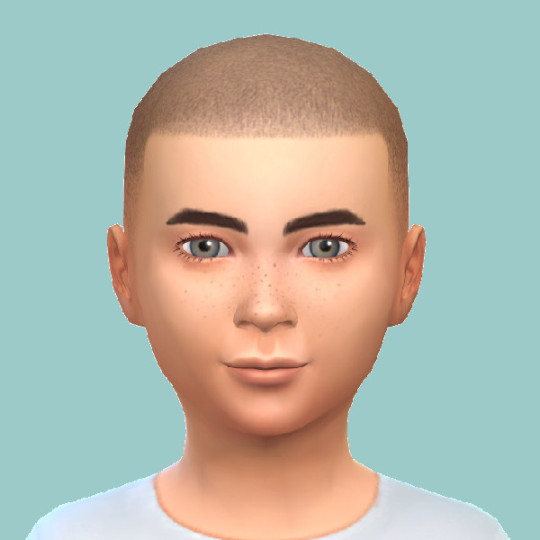
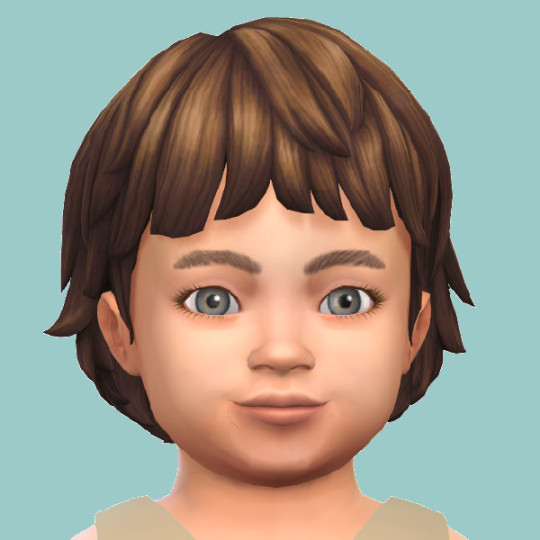
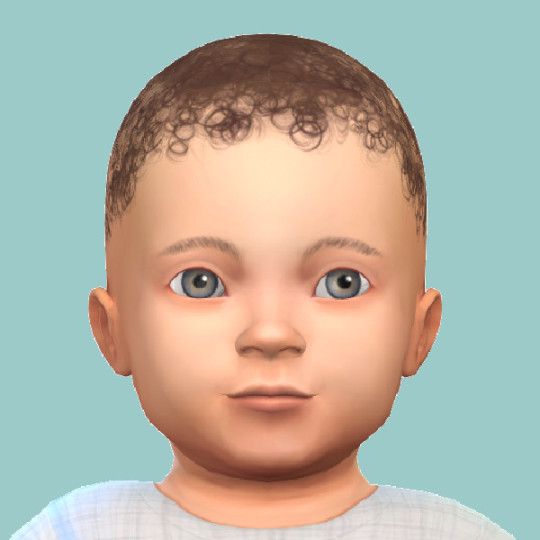

Prince Philokratis Akrisios
GENDER - Male
AGE - Child
Prince of Selinódasos
ASPIRATION - Artistic Prodigy
TRAITS: Sensitive, Language Savant
SIGN: Sagittarius
PARENTS - Laonome Amphytriona and King Akrisios I
PARTNER - None
CHILDREN - None
Download: Not available
Story: Once Upon A Time - The first ones
Family tree: The first ones
CHILD: He has the mind of an artist. He observes, he transforms, he recreate. Instinctively he processes his grief and loneliness to art. After the death of his mother he is a bit more silent, but a wonderful personality, he really is.
TODDLER: He still prefer his mother before anybody else, but then, she IS his mother, right? He already speaks two languages fluently which is amazing. And there seem to be quite a personality behind those innocent blue eyes.
INFANT: He is very attached to his mother, and he is a bit fearful of strangers. Hopefully it will change with time, because otherwise he will have a hard time as a royal person.
#Story character#Philokratis Akrisios#Generation 3#side character#Royal Family#Prince Philokratis#Once Upon A Time#Early Civilization#Royal family of Selinódasos#Prince of Selinódasos#KyriaT
0 notes
Text




Princess Nikh Akrisiou
GENDER - Female
AGE - Child
Princess of Selinódasos
ASPIRATION - Rambunctious Scamp
TRAITS: Calm, Fussy, Good
SIGN: Capricornus
PARENTS - Laonome Amphytriona and King Akrisios I
PARTNER - None
CHILDREN - None
Download: Not available
Story: Once Upon A Time - The first ones
Family tree: The first ones
CHILD: Nikh loves to run, climb and fight. Not to quarrel, but wrestling. She is strong and beat most boys her age. Her dream is to became a bull-jumper when she grows up.
TODDLER: You see, if you spoil a child like Nikh, she will become more and more demanding for attention. She is still very sweet, but OMG what a tiring kid...
INFANT: Nikh (Nike in English) was named during the Tartosa war while her mother was hoping for a victory. She doesn't seem to be a warrior, but who knows, the calm and friendly people might win in the end.
#Story character#Nikh Akrisia#Royal Family#Generation 3#side character#Princess Nikh#Once Upon A Time#Early Civilization#Royal family of Selinódasos#Princess of Selinódasos#KyriaT
1 note
·
View note